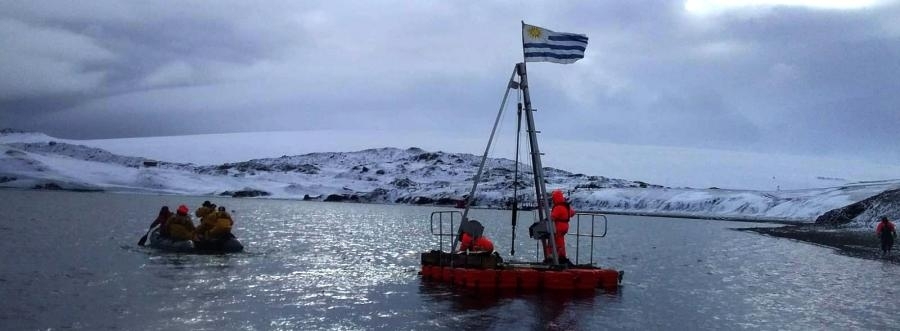


Discovered by Uruguayan scientists in 2013, two psychrophilic (cold-adapted) species have been experimented with since 2018 by a partnership between IIBCE in Montevideo and the University of São Paulo in Brazil (photo: Instituto de Investigaciones Biológicas Clemente Estable)
Published on 05/29/2023
By Ricardo Muniz | Agência FAPESP – A scientific collaboration between the University of São Paulo (USP) in Ribeirão Preto, Brazil, and Clemente Estable Institute of Biological Research (IIBCE) in Montevideo, Uruguay, is experimenting with two new bacteria discovered in the Antarctic ten years ago, in order to verify the possibility of applications in healthcare, food processing and environmental rehabilitation.
An article describing part of the results appeared in the March issue of the journal ACS Synthetic Biology, a publication of the American Chemical Society.
The use of bacteria in biotechnology offers many potential benefits for human beings and the planet, including the absence of toxic waste and lack of dependence on fossil energy sources. Bacteria are microscopic organisms that have the ability to adapt to various environments and perform a range of important functions. Bacteria retrieved from terrestrial extremes have even more interesting physiological characteristics. Antarctica is the coldest continent, with temperatures ranging from -10 °C to -60 °C in winter and from -5 °C to -20 °C in summer.
Bacteria with cold-adapted enzymes are known as psychrophiles. Enzymes are proteins that catalyze specific chemical reactions. The enzymes produced by psychrophiles are very important to biotechnological processes because they remain highly active even at low temperatures. As a result, they are less expensive and more sustainable than enzymes produced by bacteria in temperate environments.
“Bacteria isolated from the environment are often very hard to ‘domesticate’ with a view to using their enzymes. We studied two bacteria belonging to the genus Pseudomonas isolated from sediment in the Antarctic. They’re both new species that have never been described before. We set out to see if we could take advantage of their metabolism with our gene editing tools and succeeded in establishing the correct functioning of several plasmids in these two bacteria, facilitating their use for expression of psychrophilic enzymes in biotech applications,” said María Eugenia Guazzaroni, last author of the article and a professor in the Biology Department of the Ribeirão Preto School of Philosophy, Sciences and Letters (FFCLRP-USP). Her research is supported by FAPESP.
Applications
Bacterial plasmids are small DNA molecules commonly used in bacterial cloning. Expression plasmids are used to produce specific proteins. The plasmid is introduced into a cell, where it replicates, and the protein is expressed by its DNA.
Expression plasmids are widely used in scientific research and by pharmaceutical and biotech firms to produce large quantities of specific recombinant proteins for the development of medical therapies with hormones or antibodies.
Psychrophilic enzymes can also be used to produce refrigerated foods such as ice cream and yogurt with enhanced quality and texture. Yet another application involves additives in detergent and washing powder to improve the efficacy of stain and dirt removal. These enzymes function at comparatively low temperatures and can therefore be used for washing laundry in cold water, economizing energy. They also improve the quality of detergent and washing powder, so that clothes and other items made of fabric are less damaged and last longer.
Psychrophilic enzymes can also be used in bioremediation to remove pollutants from cold environments such as the Antarctic.
Cross-border collaboration
The study was conducted in collaboration with Uruguayan scientists who discovered the new bacteria in 2012 in the Antarctic and have been working with the Ribeirão Preto group since 2018. “Vanesa Amarelle, a co-author of the article, visited us as a postdoctoral fellow with a scholarship for training mobility at research institutes abroad in priority areas awarded by Uruguay’s National Research and Innovation Agency [ANII] in 2018,” said Guazzaroni, who has a PhD in biochemistry and molecular biology from Zaidín Experiment Station (EEZ) in Granada, run by Spain’s National Research Council (CSIC), with postdoctoral qualifications in environmental metagenomics and functional metagenomics of extreme environments, also earned in Spain, as well as postdoctoral studies at FFCLRP-USP.
Besides Guazzaroni and Amarelle, the other co-authors of the article are Diego M. Roldán and Elena Fabiano, both of whom are affiliated with IIBCE’s Department of Microbial Biochemistry and Genomics.
The article “Synthetic biology toolbox for Antarctic Pseudomonas sp. strains: Toward a psychrophilic nonmodel chassis for function-driven metagenomics” is at: pubs.acs.org/doi/10.1021/acssynbio.2c00543.
Source: https://agencia.fapesp.br/41500